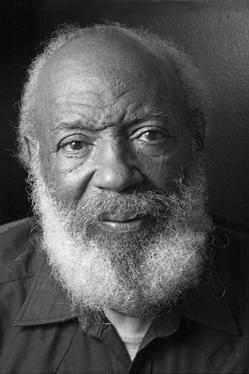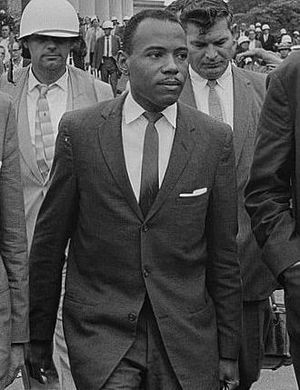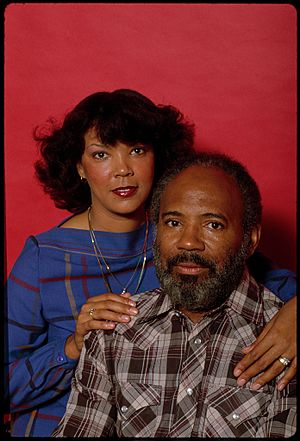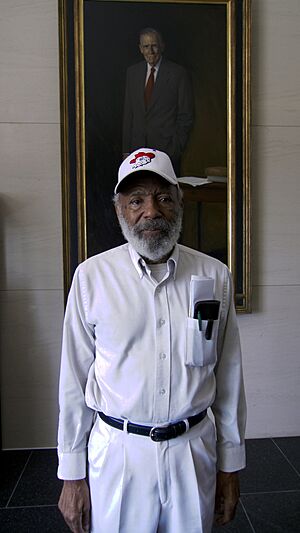James Meredith facts for kids
Quick facts for kids
James Meredith
|
|
|---|---|

Meredith in 2007
|
|
| Born |
James Howard Meredith
June 25, 1933 Kosciusko, Mississippi, U.S.
|
| Education | Jackson State University University of Mississippi (BA) Columbia University (LLB) |
| Known for | First black student at the University of Mississippi |
| Spouse(s) |
Mary June Wiggins
(m. 1956; died 1979)Judy Alsobrooks
(m. 1982) |
| Children | 4 |
James Howard Meredith (born June 25, 1933) is an American civil rights activist. He is also a writer, political adviser, and a veteran of the United States Air Force. In 1962, he became the first African-American student to be admitted to the University of Mississippi. This university was previously only for white students due to segregation.
His admission was a very important moment in the civil rights movement. It caused a lot of trouble, including the Ole Miss riot of 1962. During this time, Meredith's life was in danger. The U.S. government had to send 31,000 servicemen to stop the violence. This was the largest use of federal troops to control a riot in U.S. history.
In 1966, Meredith planned a solo walk called the March Against Fear. He walked about 220 miles from Memphis, Tennessee, to Jackson, Mississippi. He wanted to show that racism was still a big problem in the South. He also wanted to encourage African Americans to register and vote. On the second day, he was shot and hurt by a white man. Other civil rights leaders finished the march for him. When Meredith rejoined the march, about 15,000 people walked into Jackson with him. This was the largest civil rights march in Mississippi. During the march, over 4,000 African Americans registered to vote.
The University of Mississippi has honored Meredith several times. They celebrated the 40th and 50th anniversaries of his brave act. A statue of him stands on campus to remember his role.
Contents
Early Life and Education
James Meredith was born in 1933 in Kosciusko, Mississippi. His parents were Roxie and Moses Meredith. His family called him "J-Boy." He has a mixed background, including African-American, English Canadian, Scots, and Choctaw heritage. Some of his ancestors were Choctaw people who stayed in Mississippi. They chose to become U.S. citizens when many others moved to Indian Territory.
Meredith went to Attala County Training School for 11 years. This school was segregated, meaning it was only for Black students. He finished high school at Gibbs High School in Florida in 1951. After graduating, Meredith joined the United States Air Force. He served in the Air Force from 1951 to 1960.
After his military service, Meredith attended Jackson State University for two years. He earned good grades there.
Challenging the University of Mississippi
Why James Meredith Applied
In 1961, James Meredith decided to apply to the University of Mississippi. He was inspired by U.S. President John F. Kennedy. Meredith wanted to use his constitutional rights to attend the state university. At that time, the university only accepted white students. This was part of the state's segregation laws. However, the U.S. Supreme Court had already ruled in 1954 that segregation in public schools was against the law.
Meredith wrote on his application that he wanted to be admitted for his country, his race, his family, and himself. He said he felt it was his "Divine Responsibility" to do this. He knew it would be difficult but was ready to see it through.
Fighting for Admission
The university denied Meredith's application two times. During this time, he received advice from Medgar Evers. Evers was the head of the National Association for the Advancement of Colored People (NAACP) in Mississippi.
In May 1961, Meredith sued the university. He had help from the NAACP Legal Defense and Educational Fund. He argued that the university rejected him only because he was Black. He had a strong military record and good grades. After many court hearings, a federal appeals court ruled that Meredith had the right to be admitted. The state tried to appeal this to the U.S. Supreme Court, but the Supreme Court agreed with the appeals court.
Governor Barnett's Resistance
On September 13, 1962, a court ordered the university to register Meredith. But the Governor of Mississippi, Ross Barnett, said no school would be integrated while he was governor. The state quickly made a new law to try and stop Meredith. This law said people with certain crimes could not be admitted. Meredith was then wrongly accused of "false voter registration."
The federal government stepped in again. They stopped the state from using this new law. On September 20, Governor Barnett still blocked Meredith from entering the university. He did this even though university officials were ready to admit him. The court found Governor Barnett in contempt and ordered him to pay a large fine each day he refused.
Federal Government Steps In
Attorney General Robert F. Kennedy talked with Governor Barnett many times. Barnett finally agreed to let Meredith enroll. But he secretly tried to make a deal to save face.
President Kennedy sent 127 U.S. Marshals and other federal officers to protect Meredith. On September 29, President Kennedy told everyone blocking the law to stop. He said he would use the military if needed to stop any violence.
The Ole Miss Riot
On September 29, Governor Barnett gave a speech at a football game. He encouraged the crowd to block Meredith's entry. The crowd became very angry. President Kennedy sent federal marshals to Mississippi.
On September 30, 1962, Meredith moved into his dorm room. He was with Mississippi Highway Patrol and 500 federal marshals. Outside the Lyceum building, a large crowd of angry students gathered. At 7:30 p.m., the crowd started a riot. About 3,000 people threw bottles and rocks. The marshals used tear gas to control them. More than 300 people were hurt, and two people were killed.
Meredith Enrolls
The day after the riots, on October 1, 1962, federal and state forces took control. James Meredith became the first African-American student to enroll at the University of Mississippi. This was a very important moment for civil rights in the United States.
Many students bothered Meredith during his time there. They would bounce basketballs above his room at night. Others avoided him. When he went to the cafeteria, students would turn their backs or leave his table. Despite this, he kept going. He graduated on August 18, 1963, with a degree in political science.
Continuing Education and Activism
Meredith continued his studies in political science at the University of Ibadan in Nigeria. He came back to the United States in 1965. He then went to law school at Columbia University on a scholarship. He earned his law degree in 1968.
In 1966, Meredith organized his own March Against Fear. It started on June 6, 1966. He walked 220 miles from Memphis, Tennessee, to Jackson, Mississippi. He wanted to show the ongoing racial problems in Mississippi. He also wanted to encourage Black people to register and vote. This was after the Voting Rights Act of 1965 was passed.
On the second day of the march, Meredith was shot and wounded. Aubrey James Norvell, a white man, was responsible. Meredith was quickly taken to a hospital. Other civil rights leaders promised to finish the march for him. More than 10,000 people joined the march.
Norvell pleaded guilty to hurting Meredith and trying to kill him. He was sentenced to five years in prison.
Meredith recovered from his injuries. He rejoined the march before it reached Jackson on June 26. About 15,000 marchers entered the city. This was the largest civil rights march in Mississippi's history. During the march, over 4,000 Black Mississippians registered to vote. This event helped African Americans become more involved in politics.
Political Views and Legacy
James Meredith is a very independent person. He sees himself as an American citizen who demanded his rights. He does not always agree with other civil rights leaders. In 2002, he said that the idea of "civil rights" felt insulting to him. He felt it meant being a "second-class citizen."
Meredith said his main goal at the University of Mississippi was to make the federal government enforce his rights. He saw his actions as a challenge to white supremacy. He was very proud when his son, Joseph Meredith, graduated from the University of Mississippi in 2003.
Honors and Recognition
- In 2002, the University of Mississippi celebrated the 40th anniversary of Meredith's admission.
- In 2006, a statue of him was placed on the campus.
- In 2012, the University marked the 50th anniversary of his historic admission.
- That same year, Meredith received the 'Medal for Education Impact' from the Harvard Graduate School of Education. He said it was the first award he had accepted in 50 years.
Personal Life
On March 14, 1956, James Meredith married Mary June Wiggins. She was a high school English teacher. They had three sons: James, John, and Joseph Howard Meredith. Mary June Meredith passed away in 1979.
In 1982, Meredith married Judy Alsobrooks. She had a son named Kip Naylor from a previous marriage. James and Judy had a daughter named Jessica Howard Meredith. The couple lives in Jackson, Mississippi.
Works
- In 1966, his book, Three Years in Mississippi, was published.
- He has also published several other books about politics and society.
See also
 In Spanish: James Meredith para niños
In Spanish: James Meredith para niños





